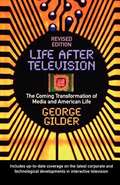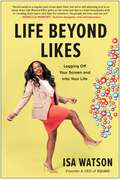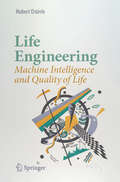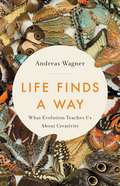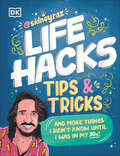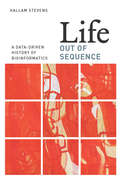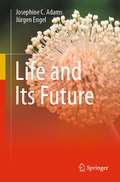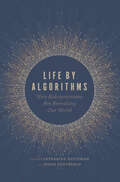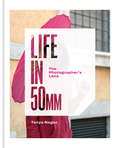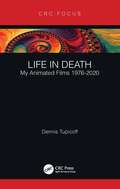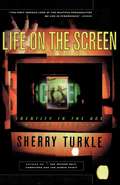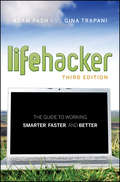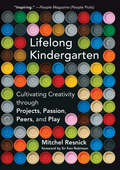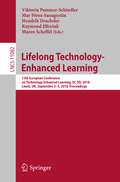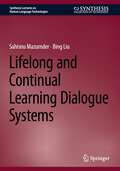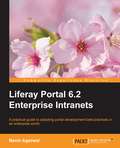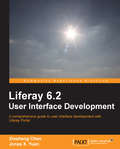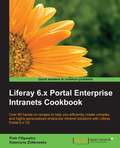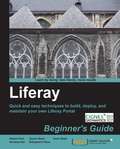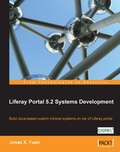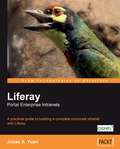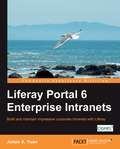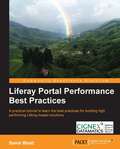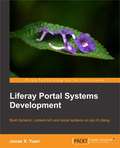- Table View
- List View
Life After Television
by George GilderPredicts that personal computers linked into a global network will soon replace television, and thereby overthrow the tyranny of mass media, renew individual power, and promote democracy worldwide. Urges American business to get on the ball with fiber optics. Reprinted from the 1990 edition published by Whittle Books. No index or bibliography.
Life Beyond Likes: Logging Off Your Screen and Into Your Life
by Isa WatsonWith so much of our lives lived online, we&’ve never been more connected—or disconnected from what&’s most important to us. It&’s time to let go of our curated online worlds and get beyond our need for likes. For all that we think we&’re getting out of social media, we&’re also getting duped. The perfection echo chamber oftentimes makes us feel like we&’re getting left behind. The truth is, life is messy, but curated online fabulousness makes it hard to let our true selves show, and it impedes our ability to have real, meaningful connections. Depression, anxiety, and suicide are also on the rise, and the virtual world is partially to blame, affecting our self-worth, our friendships, and the way we choose to navigate our real lives. As the founder and CEO of Squad, an app company built on connectedness, Isa Watson knows firsthand why we need to learn how to be more genuine. The digital world is her lifeblood, but it&’s also been an Achilles&’ heel: She struggled privately with some of the biggest challenges life can throw at you, while online she seemed to be living her best life—earning high-profile accolades, taking fabulous trips, and partying with the likes of many big name celebrities. It took a personal crisis to make her realize that she needed to change. In Life Beyond Likes, she gets real, sharing practical guidance on: Getting over the addiction to likes, and letting your true self shine Recognizing your own damaging habits and developing healthy ones Determining when a friendship has run its course Getting comfortable with discomfort in order to make real connections Drawing from a wealth of experiences including being the youngest published chemist in the world, working as executive in the upper echelons at JPMorgan Chase, and founding her own company, Isa helps readers better understand what constitutes success, identify what&’s really important, and achieve a balance between the curated online world and the enriching, emotionally nourishing world right in front of us.
Life Engineering: Machine Intelligence and Quality of Life
by Hubert OsterleMachine Intelligence is changing every aspect of our lives. Internet traffic and sensors in households, cars, and wearables provide data that oligopolistic companies collect and use to extract patterns of human behavior. Further, active digital assistants are taking over more and more of our everyday decisions. Humanity is on the verge of an evolutionary leap and it is time to determine if this development will benefit people’s wellbeing or will just mean the accumulation of capital and power with no regard for quality of life. This book integrates the perspectives of various disciplines that are striving to establish resilient foundations – computer science, economics and social sciences, political science, psychology, philosophy, neuroscience, ethics and religion – in order to clarify a number of positions and, as a result, objectify the discussions. Written by Hubert Osterle, a researcher working at the interface of these disciplines, the book promotes debate on the future of man and machine, on happiness and evolution and on the major changes brought about by digital technology. Last but not least, it is a manifesto calling for a new – integrated – discipline to be founded: life engineering.
Life Finds a Way: What Evolution Teaches Us About Creativity
by Andreas WagnerHow the principles of biological innovation can help us overcome creative challenges in art, business, and scienceIn Life Finds a Way, biologist Andreas Wagner reveals the deep symmetry between innovation in biological evolution and human cultural creativity. Rarely is either a linear climb to perfection--instead, "progress" is typically marked by a sequence of peaks, plateaus, and pitfalls. For instance, in Picasso's forty-some iterations of Guernica, we see the same combination of small steps, incessant reshuffling, and large, almost reckless, leaps that characterize the way evolution transformed a dinosaur's grasping claw into a condor's soaring wing. By understanding these principles, we can also better realize our own creative potential to find new solutions to adversity.Ultimately, Life Finds a Way offers a new framework for the nature of creativity, enabling us to better adapt, grow, and change in art, business, or science--that is, in life.
Life Hacks, Tips and Tricks: And More Things I Didn’t Know Until I Was In My 30s
by Sidney RazPacked with more than 200 shortcuts and tricks, this might just be the most helpful book you will ever own.When Sidney Raz hit 30, he realized there was so much advice no one had ever bothered to tell him. So Sid went on a mission to make his life as easy as humanly possible. He began posting his discoveries online and quickly built a following of millions, all eager for his next hacks. This book is a culmination of that work, presenting Sid’s greatest tips, tricks, and life hacks to make cooking, chores, and life in general far more efficient. It’s all stuff you wish someone had already told you, and now they have. Share them with everyone you know!Hacks that take you one step closer to domestic god status include: Placing a wet paper towel by an onion will prevent your eyes from wateringPutting plastic wrap in the freezer makes it easier to useThe shoulder strap on a leather jacket will prevent the strap on your bag from slipping off
Life Out of Sequence: A Data-Driven History of Bioinformatics
by Hallam StevensThirty years ago, the most likely place to find a biologist was standing at a laboratory bench, peering down a microscope, surrounded by flasks of chemicals and petri dishes full of bacteria. Today, you are just as likely to find him or her in a room that looks more like an office, poring over lines of code on computer screens. The use of computers in biology has radically transformed who biologists are, what they do, and how they understand life. In "Life Out of Sequence," Hallam Stevens looks inside this new landscape of digital scientific work. aaaaaaaaaaaStevens chronicles the emergence of bioinformaticsOCothe mode of working across and between biology, computing, mathematics, and statisticsOCofrom the 1960s to the present, seeking to understand how knowledge about life is made in and through virtual spaces. He shows how scientific data moves from living organisms into DNA sequencing machines, through software, and into databases, images, and scientific publications. What he reveals is a biology very different from the one of predigital days: a biology that includes not only biologists but also highly interdisciplinary teams of managers and workers; a biology that is more centered on DNA sequencing, but one that understands sequence in terms of dynamic cascades and highly interconnected networks. "Life Out of Sequence "thus offers the computational biology community welcome context for their own work while also giving the public a frontline perspective of what is going on in this rapidly changing field. "
Life and Its Future
by Jürgen Engel Josephine C. AdamsThis book is aimed at those who wish to understand more about the molecular basis of life and how life on earth may change in coming centuries. Readers of this book will gain knowledge of how life began on Earth, the natural processes that have led to the great diversity of biological organisms that exist today, recent research into the possibility of life on other planets, and how the future of life on earth faces unprecedented pressures from human-made activities. Readers will obtain a perspective on the potential risks of chemical or nuclear warfare, and the ever-increasing risks from human activities that are causing pollution and climate change with global heating. Readers will also learn about ongoing research efforts to generate “designer lifeforms” through synthetic biology and applications of artificial intelligence. The book makes an integrated, up-to-date, overview of topics often considered as separate fields. It should be valuable to students, teachers, and people who are concerned about the future of life.
Life by Algorithms: How Roboprocesses Are Remaking Our World
by Hugh Gusterson Catherine BestemanEssays on the downsides, dysfunctions, and dangers of automated decision-making: “An excellent survey of the algorithmically managed life.” —ChoiceThe phone systems that businesses use to screen calls. The link between student standardized test scores and public schools’ access to resources. The algorithms that regulate patient diagnoses and reimbursements to doctors. The impenetrable corporate bureaucracy that can drive customers in need of help up the wall—or drive them to suicide.The storage, sorting, and analysis of massive amounts of information have enabled the automation of decision-making at an unprecedented level. Meanwhile, computers have offered a model of cognition that increasingly shapes our approach to the world. The proliferation of “roboprocesses” is the result, as editors Catherine Besteman and Hugh Gusterson observe in this rich and wide-ranging volume, which features contributions from a distinguished cast of scholars in anthropology, communications, international studies, and political science.Though automatic processes are designed to be engines of rational systems, the stories in Life by Algorithms reveal how they can in fact produce absurd, inflexible, or even dangerous outcomes. Joining the call for “algorithmic transparency,” the contributors bring exceptional sensitivity to everyday sociality into their critique to better understand how the perils of modern technology affect finance, medicine, education, housing, the workplace, food production, public space, and emotions—not as separate problems but as linked manifestations of a deeper defect in the fundamental ordering of our society.“‘The Machine Stops,’ E. M. Forster’s 1909 science fiction story, tells the tale of a human society collapsing when the technology upon which it has become dependent fails. Think of [this] volume as ‘The Machine Starts,’ a collection of unsettling ethnographic accounts of the rise of algorithmic governance . . . A necessary and sobering call to arms.” —Stefan Helmreich, Massachusetts Institute of TechnologyContributors include: Catherine Besteman * Alex Blanchette * Robert W. Gehl * Hugh Gusterson * Catherine Lutz * Ann Lutz Fernandez * Joseph Masco * Sally Engle Merry * Keesha M. Middlemass * Noelle Stout * Susan J. Terrio
Life in 50mm: The Photographer's Lens
by Tanya NagarThe 50mm lens is for photography purists. It's cheap to buy, light to carry and gets amazing results. It also makes even the greatest photographers try just that little bit harder to frame the perfect image. As a result, it's the first thing anyone buys after their camera. Life in 50mm shares the greatest photos - and the personal experiences that led to them - from some of today's leading photographers. It also explains why they chose to reject complicated modern zooms and express themselves through the 50mm prime in the first place.
Life in 50mm: The Photographer's Lens
by Tanya NagarThe 50mm lens is for photography purists. It's cheap to buy, light to carry and gets amazing results. It also makes even the greatest photographers try just that little bit harder to frame the perfect image. As a result, it's the first thing anyone buys after their camera. Life in 50mm shares the greatest photos - and the personal experiences that led to them - from some of today's leading photographers. It also explains why they chose to reject complicated modern zooms and express themselves through the 50mm prime in the first place.
Life in Death: My Animated Films 1976-2020
by Dennis TupicoffDeath—the very word is resonant with emotion, imagery, and meaning. It is the ultimate life-event that all living things will eventually experience; as such, it comes as no surprise that death is often a popular theme of literature, art, games, cinema, music, and even animation. Dennis Tupicoff, world-renowned animator, writer, and producer, is an expert on the narrative application of death in animation. Take a journey with Tupicoff as he goes in-depth into the many themes, associations, and practices found in film and especially animation. Life in Death: My Animated Films 1976–2020 explores death as it relates to experience, storytelling, theory, and narrative. The examples in the very readable text are organized into three broad categories: cartoon, documentary, and hybrids of various types. KEY FEATURES Explores death as a narrative theme within cinema and animation Biographical insight into Dennis Tupicoff’s works and how the subject of death impacted these completed award-winning films Special online access to Dennis Tupicoff’s animated works In-depth exploration into ten of Dennis Tupicoff’s most influential animations
Life on the Screen: Identity in the Age of the Internet
by Sherry TurkleLife on the Screen is a book not about computers, but about people and how computers are causing us to re-evaluate our identities in the age of the Internet. We are using life on the screen to engage in new ways of thinking about evolution, relationships, politics, sex, and the self. Life on the Screen traces a set of boundary negotiations, telling the story of the changing impact of the computer on our psychological lives and our evolving ideas about minds, bodies, and machines. What is emerging, Turkle says, is a new sense of identity-- as decentered and multiple. She describes trends in computer design, in artificial intelligence, and in people's experiences of virtual environments that confirm a dramatic shift in our notions of self, other, machine, and world. The computer emerges as an object that brings postmodernism down to earth.
Lifehacker
by Adam Pash Gina TrapaniA new edition, packed with even more clever tricks and methods that make everyday life easierLifehackers redefine personal productivity with creative and clever methods for making life easier and more enjoyable. This new edition of a perennial bestseller boasts new and exciting tips, tricks, and methods that strike a perfect balance between current technology and common sense solutions for getting things done. Exploring the many ways technology has changed since the previous edition, this new edition has been updated to reflect the latest and greatest in technological and personal productivity.The new "hacks" run the gamut of working with the latest Windows and Mac operating systems for both Windows and Apple, getting more done with smartphones and their operating systems, and dealing with the evolution of the web. Even the most tried-and-true hacks have been updated to reflect the contemporary tech world and the tools it provides us.Technology is supposed to make our lives easier by helping us work more efficiently. Lifehacker: The Guide to Working Smarter, Faster, and Better, Third Edition is your guide to making that happen!
Lifelong Kindergarten: Cultivating Creativity through Projects, Passion, Peers, and Play (The\mit Press Ser.)
by Mitchel ResnickHow lessons from kindergarten can help everyone develop the creative thinking skills needed to thrive in today's society.In kindergartens these days, children spend more time with math worksheets and phonics flashcards than building blocks and finger paint. Kindergarten is becoming more like the rest of school. In Lifelong Kindergarten, learning expert Mitchel Resnick argues for exactly the opposite: the rest of school (even the rest of life) should be more like kindergarten. To thrive in today's fast-changing world, people of all ages must learn to think and act creatively—and the best way to do that is by focusing more on imagining, creating, playing, sharing, and reflecting, just as children do in traditional kindergartens.Drawing on experiences from more than thirty years at MIT's Media Lab, Resnick discusses new technologies and strategies for engaging young people in creative learning experiences. He tells stories of how children are programming their own games, stories, and inventions (for example, a diary security system, created by a twelve-year-old girl), and collaborating through remixing, crowdsourcing, and large-scale group projects (such as a Halloween-themed game called Night at Dreary Castle, produced by more than twenty kids scattered around the world). By providing young people with opportunities to work on projects, based on their passions, in collaboration with peers, in a playful spirit, we can help them prepare for a world where creative thinking is more important than ever before.
Lifelong Technology-Enhanced Learning: 13th European Conference on Technology Enhanced Learning, EC-TEL 2018, Leeds, UK, September 3-5, 2018, Proceedings (Lecture Notes in Computer Science #11082)
by Hendrik Drachsler Mar Pérez-Sanagustín Viktoria Pammer-Schindler Raymond Elferink Maren ScheffelThis book constitutes the proceedings of the 13th European Conference on Technology Enhanced Learning, EC-TEL 2018, held in Leeds, UK, in September 2018.The 42 full and short papers, 7 demo papers, and 23 poster papers presented in this volume were carefully reviewed and selected from 142 submissions. This year, the European Conference on Technology-Enhanced Learning (EC-TEL) will engage researchers, practitioners, educational developers, entrepreneurs and policy makers in a joint discussion on how to put science, technology and practice at the service of learning to embrace these challenges on the topic: Lifelong technology enhanced learning: Dealing with the complexity of 21st century challenges. Chapter "" is available open access under a Creative Commons Attribution 4.0 International License via link.springer.com.
Lifelong and Continual Learning Dialogue Systems (Synthesis Lectures on Human Language Technologies)
by Bing Liu Sahisnu MazumderThis book introduces the new paradigm of lifelong and continual learning dialogue systems to endow dialogue systems with the ability to learn continually by themselves through their own self-initiated interactions with their users and the working environments. The authors present the latest developments and techniques for building such continual learning dialogue systems. The book explains how these developments allow systems to continuously learn new language expressions, lexical and factual knowledge, and conversational skills through interactions and dialogues. Additionally, the book covers techniques to acquire new training examples for learning new tasks during the conversation. The book also reviews existing work on lifelong learning and discusses areas for future research.
Liferay 6.2 Intranet Portal Development Guide
by Navin AgarwalThis book is for anyone who is interested in the Liferay Intranet Portal. This book is for both beginners and more experienced portal developers who need to create an enterprise intranet portal for their business. It will be handy for IT professionals who know the basics of how the portal technology works and need to integrate different open source technologies.
Liferay 6.2 User Interface Development
by Xinsheng Chen Jonas X. YuanA step-by-step tutorial, targeting the Liferay 6.2 version. This book takes a step-by-step approach to customizing the look and feel of your website, and shows you how to build a great looking user interface as well."Liferay 6.2 User Interface Development" is for anyone who is interested in the Liferay Portal. It contains text that explicitly introduces you to the Liferay Portal. You will benefit most from this book if you have Java programming experience and have coded servlets or JavaServer Pages before. Experienced Liferay portal developers will also find this book useful because it explains the latest technologies used in the Liferay Portal. This book is a good reference for Liferay architects as the book also explains different technologies for portlet development and their strong and weak points.
Liferay 6.x Portal Enterprise Intranets Cookbook
by Piotr Filipowicz Katarzyna ZiolkowskaIf you are a Java developer or administrator with a technical background and want to install and configure Liferay Portal as an enterprise intranet, this is the book for you. In short, reusable recipes help you realize business goals as working features in Liferay. This book will also give you useful hints on how to easily improve the default functionality of the system and its performance.
Liferay Beginner’s Guide
by Sandeep Nair Robert ChenPart of Packt's Beginner's Guide series, each chapter follows the creation of a fictional neighbourhood site to demonstrate an aspect of Liferay portal with practical examples, screenshots, and step-by-step instructions. All you need in order to benefit from the Liferay Beginner's Guide is programming experience. No prior knowledge of Liferay is required, although experienced Liferay portal programmers who need to get up to speed with its latest features will also find this book useful.
Liferay Portal 5.2 Systems Development
by Jonas X. YuanThis book focuses on teaching by example. Every chapter provides an overview, and then dives right into hands-on examples so you can see and play with the solution in your own environment. All code samples run on both the latest Enterprise and Community releases. This book will be most useful to professional Java developers who want to build custom web sites, portals, and highly customized intranet applications using Liferay portal as a framework. This book is for Java developers, and you will get most from the book if you already work with Java but you need not have prior experience on Liferay portal. Although Liferay portal makes heavy use of open source frameworks such as Spring, Hibernate, Struts, and Lucene, no prior experience using these is assumed.
Liferay Portal Enterprise Intranets
by Jonas X. YuanThis book is a practical guide with a very user-friendly approach. The author has taken a virtual enterprise as an example and has used the features of Liferay to build a corporate intranet for that enterprise. This book is for System Administrators or experienced users (not necessarily programmers) who want to install and use Liferay in their teams or businesses without dealing with complex code. Pre-knowledge of Liferay is not expected for this book.
Liferay Portal Enterprise Intranets
by Jonas X. YuanThis book is a practical guide with a very user-friendly approach. The author has taken a virtual enterprise as an example and has used the features of Liferay to build a corporate intranet for that enterprise. This book is for System Administrators or experienced users (not necessarily programmers) who want to install and use Liferay in their teams or businesses without dealing with complex code. Pre-knowledge of Liferay is not expected for this book.
Liferay Portal Performance Best Practices
by Samir BhattA step-by-step tutorial on implementing Liferay- based portals to learn performance best practices.The book is good for Liferay portal developers and architects who want to learn performance best practices for implementing Liferay- based solutions. It is assumed that you have a working knowledge of the Liferay portal.
Liferay Portal Systems Development
by Jonas X. YuanThis book focuses on teaching by example. Every chapter provides an overview, and then dives right into hands-on examples so you can see and play with the solution in your own environment. This book is for Java developers who don't need any prior experience with Liferay portal. Although Liferay portal makes heavy use of open source frameworks, no prior experience of using these is assumed.
